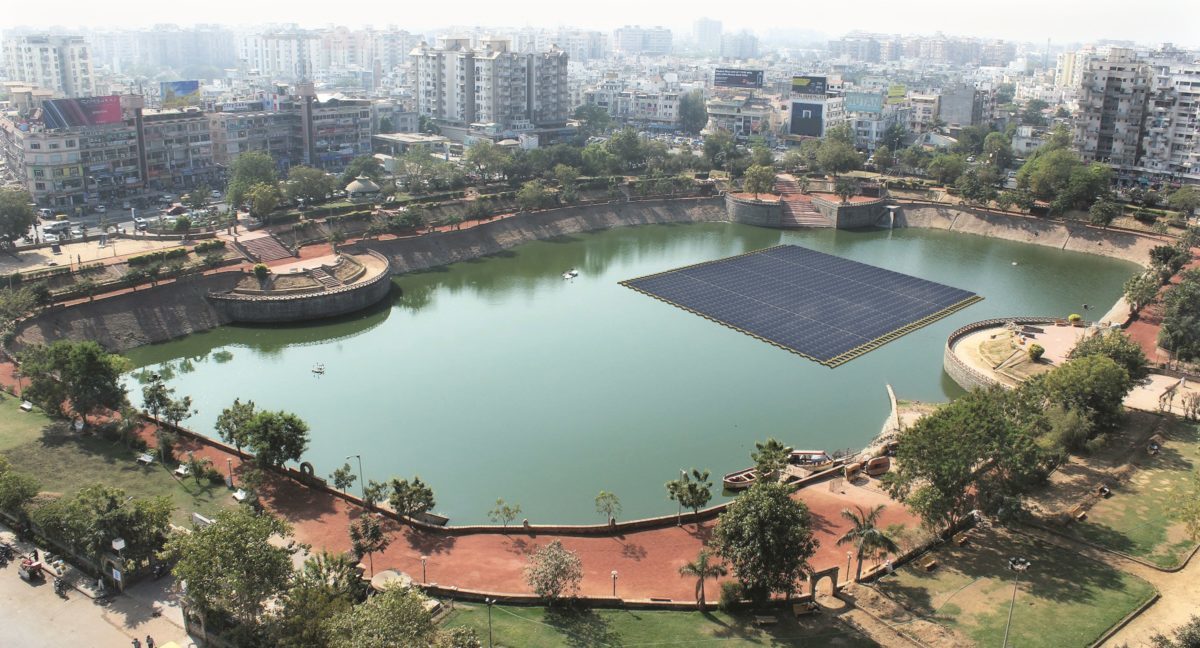With 5,264 dams covering nearly 14,000 square kilometers and countless water bodies, India has the potential to become one of the biggest hubs for floating solar PV (FSPV) projects, according to a conference at this year’s Intersolar India.
Dubbing floating solar the white knight of future mega solar projects, Hans-Henning Judek, President-CEO, Singapore-based Next Generation Solar Technologies said that the tried and tested one panel, one float solution is suited for mid-sized, rather than large projects. Conventional modules should not be used, he said, adding that the future may lie in water receivers adapted for large on-water installation.
“Typically, for 1 MW floating project, 3,333 modules of 300W are used at a cost base of $54,000 to $72,000; 6,666 cables and connectors; and 555 man hours to fix the floats together. With next-generation technology, the module cost will go down to $20,000, man-hours will be reduced to 15o hours and 180 cables will suffice,” Judek said at Intersolar 2018’s session on Floating PV: India’s Potential, Policies and Prospects.
In 2014, India’s first floating PV plant, a 10 KW system, was installed on a lake in Kolkata. Over the past three years, after the initial demonstration projects, larger projects followed, for example a 500 kW plant in Kerala and the 2 MW grid-connected plant commissioned by the Greater Visakhapatnam Smart City Corporation Limited (GVSCCL) atop the Mudasarlova reservoir.
“For any floating project, what we first need to look at is location study, ratio of fouling in the water body, below-water terrain, soil type, water current, UV radiation,” Jitendra Rami, Founder, Waterwhiz, India said.
“Robust anchoring, positioning and the choice of substrate is the key to FSPV stability,” he continued, adding, “There is a lot of talk about reinforced concrete which has 55-year life expectancy which is expensive but easy to maintain. Steel substrate is cheap to make but hard to maintain. HDPE which was introduced in India 18 years ago is also a good option. But there is no size-fits-all rule here.”
Rami predicted that large reservoirs will soon become the hub for FSPV in India.
Vinay Rustagi, Managing Director, Bridge to India went on to say that India’s floating solar value chain is “price-conscious and not value-conscious.” Concerns about quality and safety are widespread and the need of the hour is to set stringent technical standards, he added.
In the floating solar narrative, serious concerns have been raised about its environmental impact. And that is a major question Ronnie Khanna, Senior Sector Specialist Energy, KfW Development Bank, India, asks when ticking the must-dos in a financing proposal for a floating solar project.
KfW’s environmental and social feasibility standards include the requirement that 100 meters of space is left between adjacent FSPV islands for local fishermen and that the project should not cover more than 25% of a water body at the Minimum Drawdown Level (MDDL).
This content is protected by copyright and may not be reused. If you want to cooperate with us and would like to reuse some of our content, please contact: editors@pv-magazine.com.








This technology has had a rapid growth on the renewable energy, solar panels on a structure that floats on a body of water, typically an artificial basin or a lake. In addition to power generation, the system has helped significantly reduce algae growth and evaporation in the retention pond. Floating solar power system is designed for installations on freshwater surfaces, ranging from ponds and lakes to reservoirs and water storage ponds Studies claim that there is a significant improvement in efficiency putting solar panels over water. The floating structure allows the implementation of a simple cooling system.
Sir,
The idea/execution of Project for Generating Solar Power on Floating Platform is realy pretty good due to following benefits:
1. It will save fertile land surface area for Agriculture as the power is generated on water lake surface area.
2. It will conserve potable/irrigation water of the lake/pond from the dissipation due to solar rays. Thus, water body remains in the lake/pond for longer period till the monsoon period begins specially in the arid zone.
3. Such, Prefabricated Platforms of Solar panel can be installed in the very remote Coastal area where laying down power supply grid line / HT supply line is Costlier and also very costly and difficult to maintain the same due to Saline Atmosphere of the Coastal Area. Our country has the largest coastal line area where erection of such projects may become viable and fruitful that remote locality..
-SUNIL PARIKH.
Thanks for your valuable inputs Mr Parikh!